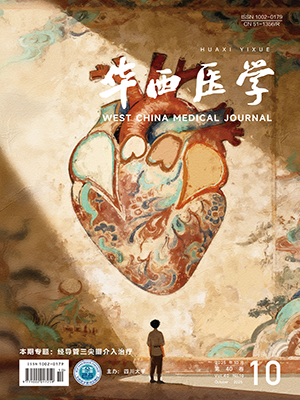| 1. |
王陇德, 刘建民, 杨弋, 等. 《中国脑卒中防治报告2017》概要. 中国脑血管病杂志, 2018, 15(11): 611-617.
|
| 2. |
Su Y, Fan L, Zhang Y, et al. Improved neurological outcome with mild hypothermia in surviving patients with massive cerebral hemispheric infarction. Stroke, 2016, 47(2): 457-463.
|
| 3. |
Yang MH, Lin HY, Fu J, et al. Decompressive hemicraniectomy in patients with malignant middle cerebral artery infarction: a systematic review and meta-analysis. Surgeon, 2015, 13(4): 230-240.
|
| 4. |
Li Y, Hou M, Lu G, et al. Decompressive craniectomy for severe middle cerebral artery infarction: a meta-analysis of randomised controlled trials. Lancet, 2016, 388(1): 92.
|
| 5. |
Pandhi A, Tsivgoulis G, Goyal N, et al. Hemicraniectomy for malignant middle cerebral artery syndrome: a review of functional outcomes in two high-volume stroke centers. Stroke Cerebrovasc Dis, 2018, 27(9): 2405-2410.
|
| 6. |
Wang Y, Reis C, Applegate RN, et al. Ischemic conditioning-induced endogenous brain protection: applications pre-, per- or post-stroke. Exp Neurol, 2015, 272: 26-40.
|
| 7. |
Hoda MN, Siddiqui S, Herberg S, et al. Remote ischemic perconditioning is effective alone and in combination with intravenous tissue-type plasminogen activator in murine model of embolic stroke. Stroke, 2012, 43(10): 2794-2799.
|
| 8. |
Loukogeorgakis SP, Panagiotidou AT, Broadhead MW, et al. Remote ischemic preconditioning provides early and late protection against endothelial ischemia-reperfusion injury in humans: role of the autonomic nervous system. J Am Coll Cardiol, 2005, 46(3): 450-456.
|
| 9. |
Tsai CF, Thomas B, Sudlow CL. Epidemiology of stroke and its subtypes in Chinese vs white populations: a systematic review. Neurology, 2013, 81(3): 264-272.
|
| 10. |
Wardlaw JM, Smith EE, Biessels GJ, et al. Neuroimaging standards for research into small vessel disease and its contribution to ageing and neurodegeneration. Lancet Neurol, 2013, 12: 822-838.
|
| 11. |
中华医学会神经病学分会.中华医学会神经病学分会脑血管病学组 中国急性缺血性脑卒中诊治指南 2014. 中华神经科杂志, 2015, 48(4): 246-257.
|
| 12. |
中华医学会神经病学分会神经重症协作组. 中国医师协会神经内科医师分会神经重症专委会 大脑半球大面积梗死监护与治疗中国专家共识. 中华医学杂志, 2017, 97(9): 645-652.
|
| 13. |
Wardlaw JM, Smith C, Dichgans M. Mechanisms of sporadic cerebral small vessel disease: insights from neuroimaging. Lancet Neurol, 2013, 12(5): 483-497.
|
| 14. |
Fazekas F, Chawluk JB, Alavi A, et al. Mr signal abnormalities at 1.5 T in Alzheimer’s dementia and normal aging. AJR Am J Roentgenol, 1987, 149(2): 351-356.
|
| 15. |
魏娜, 王拥军, 张玉梅. 脑白质病变4个分级量表的信度研究. 中国康复理论与实践, 2012, 18(6): 562-565.
|
| 16. |
Kim KW, Macfall JR, Payne ME. Classification of white matter lesions on magnetic resonance imaging in elderly persons. Biol Psychiatry, 2008, 64(4): 273-280.
|
| 17. |
Farrell C, Chappell F, Armitage PA, et al. Development and initial testing of normal reference MR images for the brain at ages 65-70 and 75-80 years. Eur Radiol, 2009, 19(1): 177-183.
|
| 18. |
Debette S, Markus HS. The clinical importance of white matter hyperintensities on brain magnetic resonance imaging: systematic review and meta-analysis. BMJ, 2010, 341: c3666.
|
| 19. |
de Leeuw FE, de Groot JC, Achten E, et al. Prevalence of cerebral white matter lesions in elderly people: a population based magnetic resonance imaging study. The Rotterdam Scan Study. J Neurol Neurosurg Psychiatry, 2001, 70(1): 9-14.
|
| 20. |
Bombois S, Debette S, Delbeuck XA, et al. Prevalence of subcortical vascular lesions and association with executive function in mild cognitive impairment subtypes. Stroke, 2007, 38(9): 2595-2597.
|
| 21. |
Sanossian N, Ovbiagele B, Saver JL, et al. Leukoaraiosis and collaterals in acute ischemic stroke. J Neuroimaging, 2011, 21(3): 232-235.
|
| 22. |
Bill O, Zufferey P, Faouzi M, et al. Severe stroke: patient profile and predictors of favorable outcome. J Thromb Haemost, 2013, 11(1): 92-99.
|
| 23. |
Feng C, Bai X, Xu Y, et al. The " silence” of silent brain infarctions may be related to chronic ischemic preconditioning and nonstrategic locations rather than to a small infarction size. Clinics (Sao Paulo), 2013, 68(3): 365-369.
|
| 24. |
Mi T, Yu F, Ji X, et al. The interventional effect of remote ischemic preconditioning on cerebral small vessel disease: a pilot randomized clinical trial. Eur Neurol, 2016, 76(1/2): 28-34.
|
| 25. |
Hougaard KD, Hjort N, Zeidler D, et al. Remote ischemic perconditioning in thrombolysed stroke patients: randomized study of activating endogenous neuroprotection - design and MRI measurements. Int J Stroke, 2013, 8(2): 141-146.
|
| 26. |
Henninger N, Khan MA, Zhang JY, et al. Leukoaraiosis predicts cortical infarct volume after distal middle cerebral artery occlusion. Stroke, 2014, 45(3): 689-695.
|
| 27. |
Ay H, Arsava EM, Rosand J, et al. Severity of leukoaraiosis and susceptibility to infarct growth in acute stroke. Stroke, 2008, 39(5): 1409-1413.
|
| 28. |
Del Bene A, Palumbo V, Lamassa M, et al. Progressive lacunar stroke: review of mechanisms, prognostic features, and putative treatments. Int J Stroke, 2012, 7(4): 321-329.
|
| 29. |
Pantoni L. Cerebral small vessel disease: from pathogenesis and clinical characteristics to therapeutic challenges. Lancet Neurol, 2010, 9(7): 689-701.
|
| 30. |
杜志顺, 姜克萍. 大面积脑梗死患者的CT和MRI检查结果及临床诊断分析. 中国校医, 2018, 32(6): 474-475.
|
| 31. |
宋英, 孙智宏, 韩光, 等. 大面积脑梗死患者的CT、MRI表现及临床诊断价值. 中国CT和MRI杂志, 2016, 14(6): 6-8.
|




